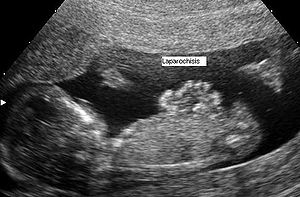Gastroschisis
| Classification according to ICD-10 | |
|---|---|
| Q79.3 | Gastroschisis |
| ICD-10 online (WHO version 2019) | |
The gastroschisis (German and belly column called Greek γαστροσχίσις from gastro ~ , "stomach ~, belly ~" and s-chísis / s chísma , "splitting") is a prenatal ( prenatal ) spontaneously arising mostly the right of the umbilicus located malformation the abdominal wall with prolapse of intestinal loops in the fetus . The peculiarity is often diagnosed by means of fine ultrasound as part of prenatal diagnostics and is operable after birth (postnatal) in most cases.
Emergence
The origin of gastroschisis is still not clear. Two main theses are discussed:
- During pregnancy , parts of the intestine shift from the abdomen into a bulge in the umbilical cord . If this sac bursts, gastroschisis can occur, the corresponding organs then float freely in the amniotic fluid .
- The other thesis says that a vascular malformation of the abdominal wall causes it to open and this leads to a hole in the abdominal wall.
According to a study, the risk of gastroschisis in newborns increases by 50 percent in pregnant women who smoke compared to pregnant women who do not smoke.
Accompanying malformations
In contrast to omphalocele, accompanying malformations in gastroschisis often only affect the intestine, predominantly intestinal atresia , i.e. H. inconsistent parts of the intestine. The spontaneous narrowing of the gap in the abdominal wall can lead to the vascular supply of the outer parts of the intestine being pinched off with the loss of the same and a loss of larger parts of the intestine.
Diagnosis
The gastroschisis can already be determined prenatally by ultrasound .
After birth, the typical malformation of the anterior abdominal wall with the loops of the intestine on the outside appears.
Action
Pregnancy with an established gastroschisis in the child should be monitored by appropriate specialists so that a spontaneous narrowing of the gap in the abdominal wall is noticed in good time. Since the organs that remain outside lie in the amniotic fluid and are damaged by the increasing concentration of child excretions in it, a planned birth is usually carried out before the actual appointment. The two goals "maximum maturity of the newborn" and "minimal damage to the organs" must be weighed.
Some centers are currently discussing the exchange of amniotic fluid in order to minimize the intestinal-damaging substances it contains.
A caesarean section is often performed at birth . The birth should take place in a center with an attached neonatal intensive care unit and pediatric surgery .
Within the first few hours after birth, the newborn child is given an initial surgical treatment to protect the loops of the bowel from infection. Either direct surgical therapy is carried out in which the intestinal loops are placed directly in the abdomen, possible accompanying malformations - as far as they are visible - are corrected and the abdominal wall is closed. More recently, in the intensive care unit, the intestinal loops can also be shifted into a sterile plastic bag, which is attached to the abdominal wall and hung over the child. In the following days the intestinal loops slide into the abdomen according to gravity, the gap can then be closed with a few sutures without any problems.
If a direct surgical therapy is carried out, with the appropriate experience of the clinic, in most cases it is possible to move the intestinal loops completely into the abdominal cavity during the first operation and to close the abdominal wall without foreign material. If foreign material has to be inserted during the operation because the abdominal cavity is too small, it will later be removed in one or more further operations. Bowel obstruction ( ileus ) is a common complication.
Course and prognosis
The postoperative diet can take a long time (sometimes several weeks). During this time the children receive all the necessary nutritional components via an infusion .
Overall, the children have a very good prognosis , but this depends on possible accompanying malformations such as stenoses and atresia.
literature
- S1 guideline for abdominal wall defects (laparoschisis [LS] / omphalocele [OZ]) of the German Society for Pediatric Surgery (DGKCH). In: AWMF online (as of 2012)
Web links
Individual evidence
- ↑ A. Hackshaw, C. Rodeck, S. Boniface: Maternal smoking in pregnancy and birth defects: a systematic review based on 173,687 malformed cases and 11.7 million controls. In: Human Reproduction Update . 17, 2011, pp. 589-604, doi : 10.1093 / humupd / dmr022 .
- ↑ D. Luton, J. Guibourdenche, E. Vuillard, J. Bruner, P. de Lagausie: Prenatal management of gastroschisis: the place of the amnioexchange procedure. In: Clinics in Perinatology . Volume 30, Number 3, September 2003, pp. 551-72, viii, ISSN 0095-5108 . PMID 14533896 . (Review).
- ^ W. Pschyrembel, Clinical Dictionary, Verlag Walter de Gruyter, 265th edition (2014) ISBN 3-11-018534-2
- ↑ W. Schuster, D. Färber (editor): Children's radiology. Imaging diagnostics. Springer 1996, ISBN 3-540-60224-0 , Volume 2, Page 396
